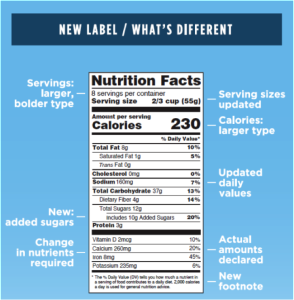After more than 20 years (1993!), the Food and Drug Administration (FDA) has finally made changes and updated the nutrition facts label that we rely on so often when choosing our foods. When I initially heard the news, I was worried the label would become more difficult to read and use, but I have been delightfully proven wrong. It seems the changes the FDA has made help to highlight some of the most important items on the label.
- Servings: The new label brings attention to the serving size and number of servings per container. The serving size, when evaluating a food item, is paramount to understanding the item itself. A consumer can pick up a box of cereal, read “calories 90,” and easily assume it is a low cal. If the consumer fails to look at the “serving size 1/3 cup” and eats 1.5 cups of the cereal, their “low calorie” cereal catapults from 90 calories to 405 calories (a 450% misinterpretation of the calories!). In addition to bringing attention to the serving size and number of servings per container, they have also adjusted the serving size (only in items they felt were relevant) to reflect the serving size consumers are now consuming. For example, that cereal box we just discussed, would have “1.5 cup” listed as a serving and not “1/3 cup.” Time will tell if consumers will see the serving size as a suggested serving or if this modification will lead to healthier choices.

- Calories: The font of the calories per serving will be increase to help draw consumers’ attention to the area.
- Daily Values: The “% Daily Values” have been updated to reflect “newer scientific evidence from the Institute of Medicine and other reports such as the 2015 Dietary Guidelines Advisory Committee Report”1. This just means the amount recommended for daily consumption has changes for some of the items, and the label has been adjust to reflect this.
- Added Sugars: This may be the change I am most excited for. We have always instructed our patients to look at the “total carbohydrates” line of the nutrition facts label, and this will not change. The new “added sugars” line will help consumers steer away (hopefully!) from food items that have a large amount of added sugars (versus naturally occurring sugars). Including the word “added” may draw attention to how far the product has deviated from its natural state (ex: dried fruit) or how unnatural and processed the item itself is (ex: Oreo cookies).
- Vitamin D & Potassium: Goodbye vitamin A & vitamin C and hello vitamin D & Potassium. Since vitamin A and C are no longer inadequate in the American diet, they have been removed and replaced with two nutrients our diets have been shown insufficient in our diets (Vitamin D & Potassium). Manufacturers have the option to continue to include Vitamin A and Vitamin C on the label, but it is no longer mandatory.
- Micronutrients: In addition to adding Vitamin D & Potassium, the label will also include the actually amount of the four mandatory micronutrients on the label (Vitamin D, Calcium, Iron, Potassium). This is super helpful, especially since a child has a different requirement for calcium than adults.
- Footnote: Daily values at the bottom of the label has been updated. The old label stated, “Percent Daily Values are based on a 2,000 calorie diet. Your daily value may be higher or lower depending on your calorie needs.” The new label reads, “The % Daily Value (DV) tells you how much a nutrient in a serving of food contributes to a daily diet. 2,000 calories a day is used for general nutrition advice.”
I’d be remiss if I didn’t mention a Graham & Roberto study evaluating the impact of the FDA label changes. They assessed visual tracking on the old nutrition facts label versus the new nutrition facts label. Their main findings were the following:
- Fewer individuals looked at the % Daily Values with the new label
- The increase in font size and bolding of the serving sizes (on the new label) and number of servings per item did not draw more attention to this area
- The “added sugars” line (on the new label) increased attention to the area
They also noticed that with both labels, the most attention was paid to the top of the label and the further down the label the information (ex: vitamin D), the less attention it received. This type of information is what helps to reconstruct these labels to provide the most impact with consumers.



